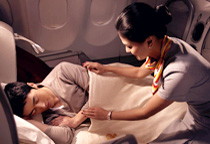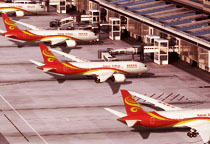制限のあるお荷物

Limits on baggage transportation
A.Prohibited items
Passengers are not allowed to place the following items in their checked baggage or carry them into the passenger cabin; otherwise Hainan Airlines and Grand China Air will refuse to provide transportation services.
I. Firearms and other weapons (including major components), devices capable of firing ammunition (including projectiles and other items) and causing serious personal injury or items that could be mistaken for such devices, mainly including: military guns, official guns, civilian guns, prop guns, firing guns, ball guns, guns outside the country, all kinds of illegally manufactured firearms and simulations of the above items, etc.
II. Dangerous goods, capable of causing serious personal injury or endangering the safety of aircraft and posing a greater danger to the order of transportation, including explosives, gases, flammable liquids, flammable solids, spontaneous combustion substances, substances that release flammable gases in contact with water, oxidizers, organic peroxides, toxic substances, infectious substances, radioactive substances, corrosives and substances and articles not belonging to any of the above categories but dangerous in air transportation. Mainly includes:
- Explosive or incendiary substances and devices or items that could be mistaken for such devices (substances), including ammunition, blasting equipment, pyrotechnic products and simulations of the above items.
- Compressed and liquefied gases, such as hydrogen, methane, ethane, butane, natural gas, ethylene, propylene, acetylene (dissolved in medium), carbon monoxide, liquefied petroleum gas, freon, oxygen (including liquid oxygen devices), carbon dioxide, water gas, lighter fuel and liquefied gas for lighters.
- Spontaneous combustion items, such as yellow phosphorus, white phosphorus, nitrocellulose (including film), oil paper and its products.
- Flammable items in contact with moisture, such as metal potassium, sodium, lithium, calcium carbide (calcium carbide), magnesium and aluminum powder.
- Flammable liquids, such as gasoline, kerosene, diesel, benzene, ethanol (alcohol), acetone, ether, paints, thinners, rosin oil and products containing flammable solvents.
- Flammable solids, such as red phosphorus, flash powder, solid alcohol, celluloid, blowing agent.
- Oxidizing agents and organic peroxides such as potassium permanganate, potassium chlorate, sodium peroxide, potassium peroxide, lead peroxide, peracetic acid, hydrogen peroxide.
- Toxic products, such as cyanide, arsenic, highly toxic pesticides and other highly toxic chemicals.
- Corrosive substances, such as sulfuric acid, hydrochloric acid, nitric acid, sodium hydroxide, potassium hydroxide, mercury (mercury).
- Radioactive materials, such as radioactive isotopes.
- Other items that implicitly contain one or more hazardous materials.
III. Control instruments that have the potential to cause personal injury or pose a significant risk to aviation safety and transport order, mainly including control knives, military and police instruments, and other control instruments as stipulated by the state.
IV. Other articles that have the potential to cause personal injury or pose a significant risk to aviation safety and transport order, mainly including
- Infectious disease pathogens, such as hepatitis B virus, anthrax bacillus, tuberculosis bacillus, and AIDS virus.
- Tinder (including various ignition devices), such as lighters, matches, cigarette lighters, and magnesium rods (flints).
- Power banks and lithium batteries with a lithium content of more than 8 grams or a rated energy of more than 160WH (watt-hours) (lithium batteries used in electric wheelchairs are otherwise regulated).
- Alcoholic beverages with an alcohol volume percentage exceeding 70%.
- Strong magnets, items with a strong, pungent smell or likely to cause panic among passengers, and items of an indeterminate nature with potential danger.
V. Security briefcases, cash boxes, cash bags, and other confidential equipment containing dangerous goods, such as lithium batteries and pyrotechnic devices, are strictly prohibited from being carried on board (except for the confidential equipment that meets the requirements of Article 2.3.2.6 of IATA's Dangerous Goods Regulations).
VI. Irritating or incapacitating devices, such as Mace, pepper spray, etc.
VII. Small gaseous oxygen cylinders (or air cylinders) and liquid oxygen devices for medical use.
VIII. Gun-type electronic dry powder fire extinguisher.
IX. Electroshock weapons (such as Tasers) that contain dangerous goods, such as explosives, compressed gases, and lithium batteries.
X. Matches of any kind (including friction matches and safety matches), lighters (including lighter fuel), and lighters driven by lithium batteries.
XI. Small scooters driven by lithium batteries, such as self-balancing scooters, unicycles, scooters, bicycles, etc., and related accessories.
XII. Self-heating ready-to-eat foods, such as self-heating rice (including instant rice and food heating packs).
XIII. Lithium batteries that may have safety defects, such as discarded lithium batteries, lithium batteries recalled by manufacturers, damaged or swollen lithium batteries, etc. Devices, such as the Samsung Galaxy Note7, are strictly prohibited in carry-on, checked, or hand baggage.
XIV. Avalanche rescue backpacks.
XV. Wild animals and animals with strange characteristics that may pose a risk, such as snakes, wolfdogs, Tibetan mastiffs, etc., do not fall into the scope of small animals and cannot be transported as baggage, except for those handled in compliance with the pet transportation regulations of Hainan Airlines and Grand China Air.
XVI. Articles that Hainan Airlines and Grand China Air consider unsuitable for transportation for the following reasons: dangerousness, lack of safety, packaging, weight, volume, size, shape, and nature of articles, as well as fragile or perishable articles taking into account the aircraft type, etc.
XVII. Other articles prohibited from transportation as stipulated by national laws, administrative regulations, and rules.
XVIII. Articles that are prohibited from exiting, entering, or transiting the People's Republic of China or the countries they pass through according to the laws of these countries.
B. Common special items:
- Items that require personal care should not be checked in or placed in checked baggage. Instead, they should be brought into the cabin as hand baggage. Examples of such items include important documents (contracts and agreements), medications, securities, currency, bills of exchange, jewellery, precious metals and their products, silver products, valuables, antiques, paintings, fragile and perishable items, samples, electronic and digital products, travel documents, medical certificates, X-rays, prescription medications that need to be taken at regular intervals, as well as any other items that require personal attention.
- Regarding liquid items, pleaseclick here to view details.
- Regarding lithium and rechargeable batteries, please refer to the "Lithium Battery Transportation Service" and "Rechargeable Battery Transportation Service" for detailed information.
- Spare batteries (including lithium batteries, nickel-metal hydride batteries and various types of dry batteries) for portable electronic devices, power banks and portable power stations are only permitted in the cabin and are prohibited in checked baggage.
- Precision instruments and electrical appliances, such as DVD players, video recorders, televisions, audio equipment, and other similar items, should be transported as cargo. If they are transported as checked baggage, they must be appropriately packaged.
- The carriage of sports equipment (including starting pistols and their ammunition) as checked baggage requires the prior consent of Hainan Airlines and Grand China Air.
- Certain small animals may be transported as checked baggage,Please click hereto view the specific requirements.
- Diplomatic bags and confidential documents must be carried by the correspondent or diplomatic courier and handled with care. On request, they can be treated as checked baggage.
- Please click here to view the special requirements for folding and electric wheelchairs used by passengers during the flight.
- Sharp or blunt objects other than controlled knives such as kitchen knives, dinner knives, fruit knives, craft knives, scalpels and scissors as well as steel files, iron cones, axes, short rods and hammers must be transported in checked baggage.
- Certain items that are prohibited but pose little risk to flight safety and are urgently needed for normal use may be accepted as carry-on baggage, provided that an appropriate certificate is issued and the items cannot easily be used to hijack an aircraft. For example, if a limited amount of medical supplies or instruments such as alcohol swabs are required to care for a seriously ill passenger seeking medical treatment at their destination, these can be taken into the cabin with the authorisation of the airport, Hainan Airlines or Grand China Air.
- Fruits that emit an unpleasant odour or may disturb other passengers, such as durian and jackfruit, are prohibited from being brought into the cabin. However, they can be placed in checked baggage and securely sealed in cardboard or plastic containers to prevent any odours from escaping.
- Carriage of securely packaged UN 0012 1.4S ammunition (intended solely for use in group sports competitions), camping stoves and fuel containers containing flammable liquid fuel, approved security equipment, non-infectious samples packed with minimal flammable liquids, combustion and fuel cell engines, and osmosis devices is strictly prohibited in the cabin. Check-in procedures can only proceed with our approval.
- Carriage of securely packaged UN 0012 1.4S ammunition (intended solely for use in group sports competitions) and osmosis devices: Please make necessary preparations beforehand and present the certification/MSDS sheets to the airport personnel as evidence of compliance with our regulations.
- Eligible security equipment, chemicals, monitoring devices: Please make necessary preparations beforehand and present the certification/MSDS sheets to the airport personnel as evidence of compliance with our regulations.
- Non-infectious samples packed with minimal flammable liquids: Please make necessary preparations beforehand and present to the airport personnel an appraisal report issued by the Health Commission or a medical unit within China at the county or municipal level or at the same level (e.g., national grade 2A) or above, with official seal (including the date of issuance).
- Regarding dry ice (solid carbon dioxide) for the preservation of fresh and perishable items, passengers are permitted to carry a maximum of 2.5kg with our approval. The package must have vent poles to release the gas. Meanwhile, dry ice (solid carbon dioxide) cannot be transported alone as carry-on or checked baggage. It must be transported alongside the perishable items.
- Aquatic products:
(1) Transport scope
Applicable to domestic flights only.
(2) Transport requirements
When aquatic products are checked in as baggage, each transport package should weigh not more than 30kg, and the dimensional requirements are the same as those for ordinary baggage.
(3) Provisions on aquatic product packages
A. Transport packages for aquatic products must be firm, sealed, odorless, and free from liquid leakage, and must not damage passengers' baggage, or the aircraft's facilities, equipment and other cargoes; they must be able to withstand abrupt changes in temperature and air pressure, and have a certain level of compressive strength so that they will not be damaged during normal air transport.A package must be in the form of a foam box wrapped by a carton. The foam box must have four walls, a bottom and a top. The thickness of the walls should not be less than 2cm, and the body should be free from any damage or crack.The bottom of the foam box should be covered with an absorbent material, such as absorbent paper, absorbent sponge or sawdust.The size of the carton should match that of the foam box, and it is prohibited to put two foam boxes in one carton.Any foam box or carton that is damp, or folded and deformed, or any recycled used foam box or carton should not be used as a transport package for aquatic products.
B. A sealed ice bag or a plastic bottle containing 80% ice can be placed inside the package for preservation.If dry ice is contained, the airline's dry ice transport standard must be complied with.
C. We assume the liability for compensation for aquatic products whose loss is attributed to Hainan Airlines only.
If you have any questions or feedback, kindly contact the 24-hour booking service hotline of Hainan Airlines and Grand China Air at 95339.
C.Checked Baggage Limitations
Checked in baggage shall be packed, locked or tied securely, be able to bear certain pressure, can be safely loaded or unloaded under normal operations, and must be subject to the following rules:
- Travelling cases, bags and handbags shall be locked.
- Two or more bags cannot be tied together as one.
- No other items can be attached to the baggage.
- Bamboo basket, string bag, straw ropes, straw bags and other similar articles cannot be used as a package of baggage.
- Baggage with dangerous markings or tags cannot be used. The dangerous markings or tags shall be removed or covered before the baggage can be used.
- Sawdust, rice husk or grass items cannot be used as padding in the baggage.
- The edges and corners of the hard material outer packaging and the irregular, uneven or sharp protrusions of the packaging surface must be softened, and the soft packing lining materials (such as: foam, sponge, linen, cardboard, bubble film, etc.) must play a protective role in principle to avoid rubbing.
リチウム電池の輸送サービスについて
現行の有効な国際民間航空機関(ICAO)の『危険物を空輸するための技術的指示』(国際便及び中国国内便に適用)に基づき、旅客の手荷物におけるリチウム電池の輸送規定に関する注意事項は以下の通りとなります。
- 電池のリチウム含有量が2g以下(リチウム金属電池)、または定格出力が100Wh以下(ワット時定格量、リチウムイオン電池)である旅客の個人用電子機器(腕時計、計算機、カメラ、携帯電話、ノートパソコン、ビデオカメラ等)は、受託手荷物または機内持ち込み手荷物として輸送することができます。電子機器の定格出力が100Whを超え、160Wh以下である場合、海南航空、大新華航空の許可を得た上、受託手荷物または機内持ち込み手荷物として輸送することができます。受託手荷物として輸送する場合は、偶発的な損傷を避けるために、事前に電子機器の梱包を十分に行った上、本体の電源を完全に切り、電子機器が最起動されないように、予め然るべき対策を取らなければなりません。
- 予備リチウム電池のお預けは禁止されています。手荷物として機内持ち込みできます。機内へ持ち込む予備リチウム電池は、短絡防止措置(ショート防止)を講じる必要があるため、正しい方法としてそれぞれの電池を1つずつ小さなケースに入れ、またはリチウム電池輸送用の専用袋に入れる必要があります。モバイルバッテリーも予備リチウム電池の一種とみなされるため、航空機に搭乗する際、予備リチウム電池と同様の輸送規定が適用されます。また、機内へ持ち込まれたモバイルバッテリーを使用して、携帯電話やその他の電子機器に充電することは禁止されています。
- 旅客の個人用電子機器の予備リチウム電池のリチウム含有量が2g以下、または定格出力が100Wh以下の場合は、手荷物として機内持ち込みできます。お預けはできません。予備リチウム電池の定格出力が100Whを超え、160Wh以下である場合、海南航空、大新華航空の許可を得た上、最大2個まで機内持ち込みできます。
- 旅客が携行するリチウムイオン電池を原動力とする車椅子またはその他の類似の移動補助器具や、医療用途のために携行する、リチウム金属またはリチウムイオン電池セルまたは電池を内蔵した携帯型医療用電子機器及びその予備電池は、最新版の『危険物を空輸するための技術的指示』の輸送・包装要求に基づいて携行し、海南航空、大新華航空の許可を受ける必要があります。携帯型医療用電子機器の予備電池は定格出力が160Wh以下、またはリチウム含有量が8g以下である場合、海南航空、大新華航空の許可を得た上、1人につき最大2個まで手荷物として機内に持ち込むことができます。お預けはできません。
- 電動車椅子またはその他の移動補助器具の予備リチウム電池は、海南航空、大新華航空の許可を得た上、手荷物として、電池の定格出力が160Wh以下の場合は1人につき最大2個まで、定格出力が160Whを超え、300Wh以下の場合は1人につき最大1個まで、機内に持ち込むことができます。お預けはできません。
- サムスンのGalaxy Note7、小型リチウム電池駆動のバランススクーター(一輪スクーター、電動ボード、ミニセグウェイなどその他の類似製品も含む)及びその関連部品を機内持ち込み手荷物または受託手荷物として輸送することを禁止されています。
- リチウム電池や点火器などの危険物を内蔵したキャッシュボックス、アタッシュケース、現金袋などの機密性の高い荷物の輸送は禁止されています。
民間航空ご利用者のモバイルバッテリー持ち込み規定に関するお知らせ
お客様各位:
海南航空をご利用いただきありがとうございます。民用航空局の要請により、お客様がモバイルバッテリーを機内持ち込みされる場合の規定をお知らせします。
モバイルバッテリーとは、携帯電話などの電子機器に外部電源を提供することを主な機能とするリチウム電池モバイルバッテリーを指します。国際民間航空組織が公布した現在有効な「危険物安全航空輸送技術細則」と「中国民間航空危険物輸送管理規定」により、お客様が
機内に持ち込みされるモバイルバッテリーについて、次の規定をお守りください。
1. モバイルバッテリーはお客様本人が個人で使用するために携帯してください。
2. モバイルバッテリーは機内持ち込み荷物に入れるか、お手回り品としてお持ちください。受託手荷物に入れることはできません。
3. モバイルバッテリーのワット時定格量が100Wh未満の場合、航空会社の許可は不要です。ワット時定格量が100Whを超え160Wh以下の場合、お持ち込みには航空会社の許可が必要です。ただし、お客様1名につきお持ち込みできるモバイルバッテリーは2個までとなります。
4. ワット時定格量が160Whを超えるモバイルバッテリーのお持ち込みは厳禁とします。ワット時定格量が未記載かつ表記が許可されていない他のパラメータにより計算されたワット時定格量のモバイルバッテリーもお持ち込みいただけません。
5. 運航中は、モバイルバッテリーを使って電子機器を充電しないでください。スイッチがあるモバイルバッテリーは、運航中はスイッチをオフにしてください。
モバイルバッテリーのワット時定格量の判定方法:
充電器にワット時定格量Wh(ワット時)の記載がない場合、次の方法で換算できます。
① モバイルバッテリーの公称電圧(V)と定格定量(Ah)がおわかりの場合、計算によって定格量を求められます。
Wh= V x Ah
通常、公称電圧と定格定量はモバイルバッテリーに記載されています。
② モバイルバッテリーにミリアンペア(mAh)の記載しかない場合、この数値を1000で割るとアンペア時(Ah)が得られます。
例:モバイルバッテリーの公称電圧が3.7V、定格定量が760 mAh の場合、ワット時定格量は次のとおりです。
760 mAh ÷ 1000 = 0.76Ah
3.7V×0.76Ah=2.9Wh
Transportation Services for Powder Articles
I. Tips for Inspection of Powder Articles for Passengers travelling to the United States
Starting from June 30, 2018, the United States has implemented focused inspections on powder articles carried by passengers travelling to the United States. Powder articles with a container volume (single) exceeding 350ml (including) and articles presented in a solid state by compressing powdery materials (such as flour, sugar, coffee, spices, and pastries) cannot be brought into the cabin. If you need to carry such articles, please arrange your trip in advance and check them in at the airport.
The following two types of special powder articles must meet the following requirements if they are to be brought into the cabin.
(1)For powder articles such as medical drugs, infant formula, and cremated remains
Ensure that the packaging is intact and without any signs of damage (including cracks, punctures, etc.). If the packaging is not sealed or displays any signs of damage, ensure that the articles inside the packaging match the description on the packaging.
(2) For powder articles purchased by you at the airport duty-free shops
Ensure that they are sealed in a container or a sealed bag and undergo inspection by airport security personnel.
II. Tips for Inspection of Powder Articles for Outbound Passengers from Australia and New Zealand
Starting from June 30, 2018, Australia and New Zealand have implemented focused inspections on powder articles carried by passengers departing on international flights. Inorganic powder articles with a container volume (single) exceeding 350ml (including) cannot be brought into the cabin. If you need to carry such articles, please arrange your trip in advance and check them in at the airport.
The following two types of special powder articles are exempt from the above regulations. If you need to bring them into the cabin, they must meet the following requirements.
(1) For organic powdery materials, such as medical drugs, infant formula, coffee, protein powder, laxatives (magnesium sulfate), and cremated remains
Ensure that the packaging is intact and without any signs of damage (including cracks, punctures, etc.). If the packaging is not sealed or displays any signs of damage, ensure that the articles inside the packaging match the description on the packaging.
(2) For powder articles purchased by you at the airport duty-free shops
Ensure that they are sealed in a container or a sealed bag and undergo inspection by airport security personnel.





